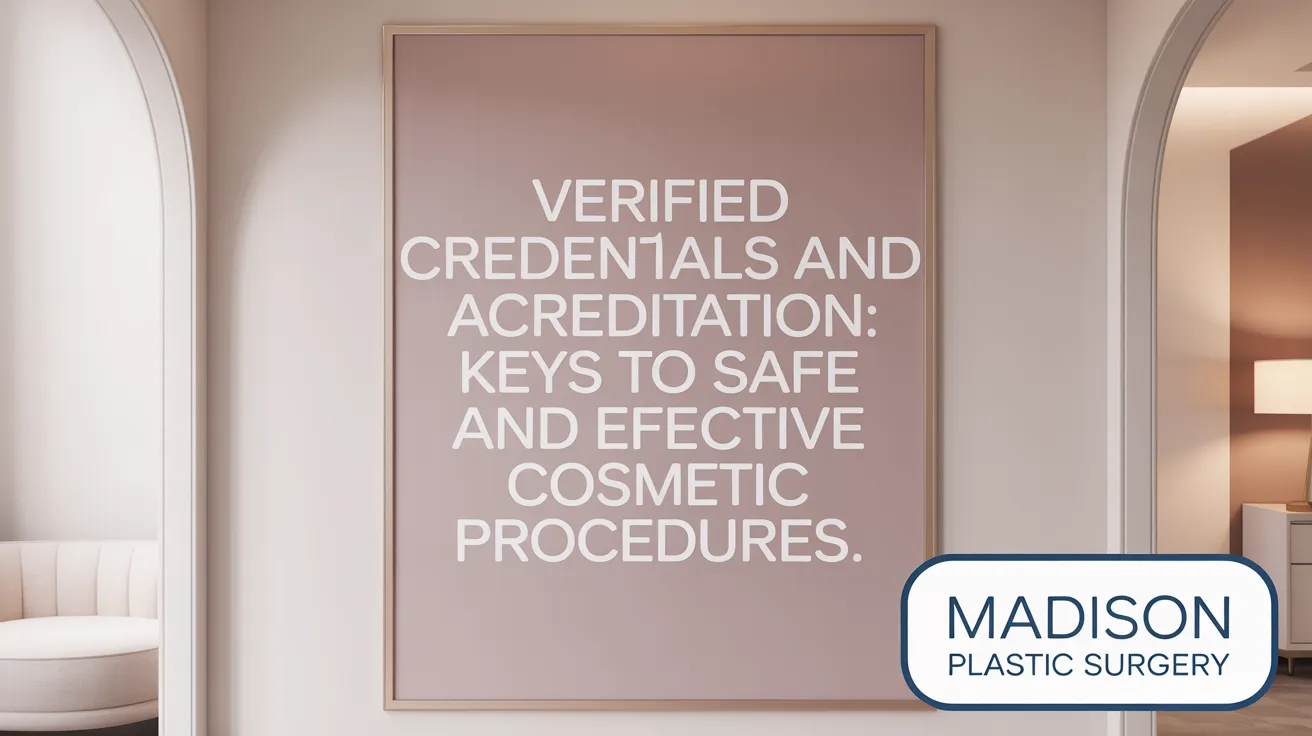Why Accreditation is a Critical Factor in Cosmetic Surgery Safety
Choosing a cosmetic surgery provider is a decision that significantly impacts your safety and surgical outcomes. Accreditation and board certification are key indicators that a surgeon and their facility uphold rigorous safety and quality standards. This article explores why selecting accredited providers and board-certified surgeons matters, highlights the criteria behind accreditation and certification, and offers practical advice on evaluating cosmetic surgery options to ensure the best possible care.
<!-- VIDEO:eyJsaW5rIjoiaHR0cHM6Ly93d3cueW91dHViZS5jb20vd2F0Y2g/dj0wWVVqYm5YcVVNcyIsImltYWdlVXJsIjoiaHR0cHM6Ly9lbmNyeXB0ZWQtdnRibjAuZ3N0YXRpYy5jb20vdmlkZW8/cT10Ym46QU5kOUdjUUx1a1dJbHBNdTRvMTQyVDkzaEJtLWc2VnFyOHQ4aGFld3VRIiwidGl0bGUiOiJOZXcgQmVhdXR5IE1hZ2F6aW5lIC0gQ2hvb3NlIFlvdXIgU3VyZ2VvbiBHdWlkZSAuLi4iLCJzbmlwcGV0IjoiLi4uIFN1cmdlb25zIDIxOjU3IERlcm1hdG9sb2dpc3RzIDI4OjEwIENvc21ldGljIERlbnRpc3RzIDMxOjA4IFF1ZXN0aW9ucyB0byBhc2sgNDI6NDIgU2FmZXR5IC4uLiBXaHkgQm9hcmQgQ2VydGlmaWNhdGlvbiBNYXR0ZXJzOiDigKIgV2h5IEJvYXJkwqAuLi4ifQ== -->Understanding Accreditation: Setting the Standard for Safety and Quality

Why is choosing an accredited cosmetic surgery facility important for safety and quality assurance?
Opting for an accredited cosmetic surgery center is essential to ensure that patients are getting care in a safe, hygienic, and professionally managed environment. Accreditation signifies that the facility has met strict standards established by reputable organizations such as the AAAASF, AAAHC, or The Joint Commission.
These standards cover multiple critical aspects of surgical safety, including proper sterilization practices, state-of-the-art equipment, qualified and licensed staff, and emergency response preparedness. Facilities undergo regular inspections and audits to maintain their accreditation status, fostering ongoing adherence to high-quality care practices.
The accreditation process also ensures that the facility complies with laws like HIPAA for patient privacy, maintains safety protocols for infection control, and is equipped with backup power and emergency equipment for unforeseen circumstances. This external validation provides patients with confidence that their surgery will be performed in an environment committed to safety and excellence.
Moreover, properly accredited centers typically employ board-certified surgeons and anesthesiologists, further reducing the risk of complications. Overall, choosing an accredited clinic elevates the standard of care, enhances safety, and supports better surgical outcomes.
Criteria and standards for facility accreditation
Accrediting bodies evaluate facilities based on strict criteria, including infrastructure, sterilization, staff qualifications, emergency protocols, and patient care procedures. They assess the facility’s readiness for handling emergencies, the cleanliness of the environment, and the availability of appropriate medical technologies.
Standards also mandate ongoing staff education, regular equipment maintenance, and compliance with federal and OSHA regulations. Facilities must demonstrate consistent quality through detailed documentation and self-surveys, with external inspections every few years.
Role of major accrediting organizations in cosmetic surgery
In the United States, organizations like AAAASF, AAAHC, and the Joint Commission are recognized leaders in certifying surgical centers. Their evaluations ensure that outpatient clinics meet hospital-level safety standards.
These accrediting bodies verify that the facility employs qualified medical staff, has proper emergency plans, and maintains sterile environments. They also scrutinize policies on patient privacy, staff training, and infection prevention.
Facilities that are accredited by these agencies often display their accreditation logos publicly, allowing patients to verify their safety credentials easily.
Impact of accreditation on safety and quality assurance
Accreditation directly correlates with safer surgical practices and higher quality standards. Data shows that accredited facilities have lower complication and infection rates. They also promote a culture of continuous improvement and accountability.
For patients, this means a reduced risk of adverse outcomes, greater confidence during recovery, and peace of mind knowing their health is prioritized. Ultimately, facility accreditation elevates the standard of cosmetic surgery and solidifies trust between patient and provider.
The Significance of Board Certification and Surgeon Qualifications
What is the significance of board certification and qualifications of plastic surgeons?
Board certification of plastic surgeons holds considerable importance because it confirms that the surgeon has undergone comprehensive, specialized training in plastic and reconstructive procedures. This process involves extensive coursework, passing rigorous written and oral examinations, and accumulating several years of surgical experience. Certified surgeons are committed to high standards of safety, ethics, and ongoing education, which ensures they stay updated with the latest advancements and techniques.
Certified plastic surgeons are also trained to operate in accredited surgical facilities, manage potential complications effectively, and follow strict safety protocols such as those outlined in AAAASF standards for cosmetic surgery and safety protocols in plastic surgery. All these factors significantly reduce the risk of adverse outcomes and enhance patient safety. Importantly, among various certifications, the American Board of Plastic Surgery (ABPS) is the only credential recognized by the American Board of Medical Specialties (ABMS) specifically for plastic surgeons. This recognition provides assurance that the surgeon has achieved the highest standards in their field.
Choosing a board-certified surgeon increases the likelihood of achieving natural, satisfying results while minimizing risks. Patients should prioritize certification and credentials when selecting their surgeon to ensure a safe and successful surgical experience.
How can patients verify surgeon credentials and professional memberships?
Patients can verify their surgeon's credentials through several reputable resources. The most direct method is checking the American Board of Surgery (ABS) certification database, which provides current certification status. Additionally, the ABMS Certification Matters website allows patients to verify if their surgeon holds certification from recognized ABMS member boards, including the American Board of Plastic Surgery (ABPS).
For comprehensive verification, the Federated Credentials Verification Service (FCVS) can confirm the authenticity of medical education, training, and licensing records directly from primary sources. Patients should also request official proof of licensure and professional memberships from their surgeon. Most importantly, verifying the surgeon's certifications, licensure, and memberships through state medical boards and professional societies ensures the surgeon adheres to established standards.
Utilizing these verification tools together helps patients make informed decisions, ensuring their chosen surgeon is qualified, experienced, and committed to providing high-quality care.
| Verification Resource | What It Checks | Additional Notes |
|---|---|---|
| ABMS Certification Matters | Board certification status | Verify if surgeon is certified by recognized ABMS boards |
| FCVS | Education, training, licensure | Centralized source for primary-source credential verification |
| State Medical Boards | License status, discipline | Ensure current licensing and check for disciplinary actions |
| Professional Society Memberships | Membership validity | Confirm active memberships in professional organizations |
By verifying credentials through these channels, patients can confidently select a qualified and reputable plastic surgeon for their procedures.
Rigorous Safety Protocols and Standards in Accredited Cosmetic Surgery

What safety protocols and practices do reputable cosmetic surgery providers follow?
Reputable cosmetic surgery providers prioritize patient safety through the implementation of comprehensive safety protocols. These include performing surgeries in accredited facilities certified by organizations such as the American Association for Accreditation of Ambulatory Surgery Facilities (AAAASF) or the Joint Commission. Such accreditation confirms adherence to strict standards for cleanliness, safety, and qualified staff.
Staff qualifications are critical; qualified personnel, including board-certified anesthesiologists or nurse anesthetists, oversee anesthesia administration and vital monitoring during procedures. These providers are trained to respond promptly to any intraoperative emergencies.
Sterilization and infection control are foundational practices. All surgical instruments are thoroughly sterilized, and the operating environment is disinfected regularly to prevent bacterial contamination. Strict aseptic techniques, proper hand hygiene, and PPE usage contribute to minimizing infection risks as described in plastic surgery safety standards.
Preoperative safety measures involve detailed patient evaluations, including medical history, physical exam, and risk assessment to identify potential complications. Operative site marking and confirmation protocols, such as the 'time out' procedure, help prevent wrong-site or wrong-procedure errors, aligning with ASPS patient safety recommendations.
Intraoperative safety is supported by continuous monitoring of vital signs, appropriate use of anesthesia, and readiness with backup equipment in case of emergencies. Emergency protocols are well-documented and regularly practiced, consistent with surgical facility accreditation standards.
Postoperative care extends to careful monitoring of recovery, patient education on warning signs of complications, and scheduled follow-up visits. Early detection and management of issues like bleeding or infection are vital for safe outcomes, in accordance with best practices in plastic surgery patient care.
Together, these protocols and standards ensure high-quality, risk-aware cosmetic surgical care, emphasizing the importance of choosing facilities and surgeons that comply with recognized safety practices and accreditation.
How Accreditation and Credentials Directly Influence Patient Outcomes
 Accreditation and proper credential verification are fundamental to ensuring high-quality patient care and positive health outcomes in cosmetic surgery. Facilities that are accredited by recognized organizations such as AAAASF, AAAHC, or The Joint Commission are required to meet rigorous standards for safety, sanitation, equipment, and staff qualifications. These stringent protocols reduce risks of infections, complications, and errors, contributing to safer surgical experiences.
Accreditation and proper credential verification are fundamental to ensuring high-quality patient care and positive health outcomes in cosmetic surgery. Facilities that are accredited by recognized organizations such as AAAASF, AAAHC, or The Joint Commission are required to meet rigorous standards for safety, sanitation, equipment, and staff qualifications. These stringent protocols reduce risks of infections, complications, and errors, contributing to safer surgical experiences.
Verified credentials of surgeons and staff—such as board certification from bodies like the American Board of Plastic Surgery—affirm that practitioners have completed extensive training, passing comprehensive exams, and maintain ongoing education. This professional rigor ensures that only qualified, experienced individuals perform surgeries, which significantly lowers the likelihood of adverse outcomes.
Facilities that maintain accreditation participate in continuous quality improvement processes. Regular inspections and audits ensure compliance with evolving safety standards and help identify and address potential issues promptly. Such oversight fosters a culture of safety and accountability, enhancing surgical success rates and patient satisfaction. See more about Surgical Facility Accreditation.
In the context of medical tourism and complex cases, accreditation becomes especially critical. Patients seeking care abroad or in high-risk procedures should prioritize accredited centers to mitigate risks associated with unregulated environments. Verification of accreditation status through official directories or direct inquiry aids patients in selecting trustworthy providers. Learn about Seeking Safe Surgery.
In summary, accreditation and credential verification serve as vital indicators of a facility’s commitment to safety, professionalism, and quality. They directly influence the likelihood of favorable patient outcomes by minimizing risks and ensuring that procedures are performed in a controlled, safe environment.
Practical Guidance: Selecting a Safe Cosmetic Surgery Provider and Non-Surgical Treatment Experts
How can patients evaluate and select a safe, qualified cosmetic surgery provider?
Patients aiming for safe and successful cosmetic procedures should start by verifying their surgeon’s credentials. The most important step is ensuring the surgeon is certified by the American Board of Plastic Surgery (ABPS), which signifies they have completed rigorous training, including a plastic surgery residency and comprehensive exams. Additionally, confirm that the surgical facility is accredited by recognized bodies such as the AAAASF, AAAHC, or the Joint Commission, and licensed by the state. Accreditation indicates the facility meets high safety and hygiene standards, with qualified staff and emergency preparedness.
Experience with the specific procedure is crucial. Patients should ask their prospective surgeon about their experience, review before-and-after photos, and inquire about complication rates. Surgeons with hospital privileges to operate in accredited hospitals demonstrate further competence. Anesthesia safety is another vital factor—ensure that anesthesia is administered by licensed, qualified anesthesiologists or nurse anesthetists in accredited settings.
Using resources like the American Society of Plastic Surgeons’ ‘Do Your Homework’ initiative, patients can find information on surgeon qualifications and safety standards. Overall, a thorough consultation, verification of credentials, experience, and facility accreditation are essential steps in choosing a surgeon who prioritizes patient safety.
What tips can help ensure safety when undergoing cosmetic injections and non-surgical treatments?
Safe non-surgical treatments such as neurotoxins and fillers depend heavily on provider qualification and environment. Patients should ensure treatments are performed by licensed, experienced medical professionals—ideally physicians with specific training in cosmetic injections—within accredited clinics or medical offices. It’s important to verify that the provider holds certification from recognized medical boards and that the products used are FDA-approved and sourced from reputable suppliers.
Prior to treatment, patients should have a detailed consultation where the provider reviews medical history, discusses potential risks, and outlines clear pre- and post-treatment care instructions. Maintaining strict sterile techniques is fundamental to reducing infection risk.
Additionally, patients should avoid treatments administered in non-medical environments such as malls, salons, or private parties. Always review before-and-after photos, and consider feedback from reviews and testimonials, to gauge the provider’s skill. If any adverse effects occur, patients should contact their healthcare provider immediately. These precautions are vital to minimize risks and achieve safe, natural-looking results. For more guidance on choosing qualified providers for injectable treatments, see Choosing a provider for injectable treatments.
Making Informed Choices for Safe Cosmetic Procedures
The decision to undergo cosmetic surgery or non-surgical treatments should be underpinned by careful evaluation of surgeon credentials and facility accreditation. Board certification from organizations like the American Board of Plastic Surgery assures extensive training and adherence to ethical standards. Likewise, choosing facilities accredited by recognized bodies guarantees compliance with strict safety protocols, quality equipment, and suitably qualified personnel. Patients are encouraged to verify credentials, review outcomes, and ensure anesthesia and surgical environments meet the highest standards. By prioritizing accreditation and certification, individuals significantly reduce risks, enhance safety, and improve their chances of achieving desired and lasting results. Ultimately, informed choices empower patients and promote a culture of excellence and trust in cosmetic surgery.
